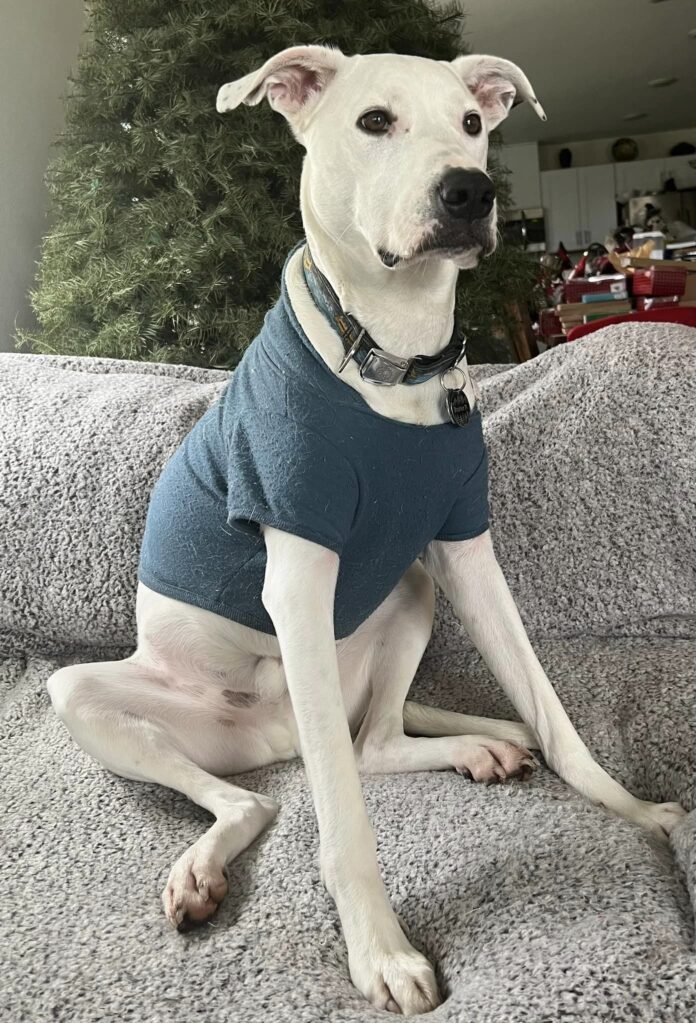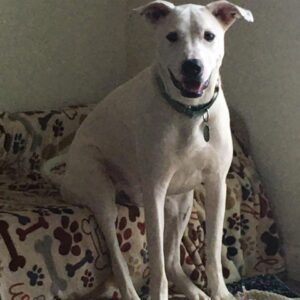
Pythiosis is a rare but deadly disease in dogs, humans, horses, and other mammals. In dogs, it is characterized by either non-healing sores on the skin, or the rapid growth of lesions in the stomach and intestine – masses that quickly obstruct the digestive tract.
This illness was originally described by British veterinarians studying horses with skin lesions in India in 1884. It is endemic to tropical and subtropical regions of the world, including Thailand, India, Brazil, and the U.S. states that border the Gulf of Mexico. However, in the past 20 years, it has increased its range into atypical areas, including northern California and Wisconsin. Pythiosis case reports have increased in the past decade.
Cause of pythiosis
Pythiosis is caused by the oomycete Pythium insidiosum. Oomycetes (pronounced oh-uh-MY-seats) are organisms that act and look like a fungus but are more closely related to algae. They are often referred to as “water molds.” P. insidiosum needs water to complete its life cycle. It is typically found in stagnant water, such as that found in ponds, swamps, and bayous, but can also be found in moist soil. P. insidiosum is attracted to grasses and other aquatic vegetation, human and horse hair, and the skin of mammals.
Finding this organism in ponds, swamps, and bayous makes sense when we think about the typical tropical and subtropical geographic distribution of pythiosis. It is not entirely understood why we are now diagnosing pythiosis in animals living in arid or colder regions of the country and that have no travel history outside of their home area. There is some speculation that there may be a connection between agricultural irrigation practices in these regions and exposure to P. insidiosum. Some experts speculate that global warming is helping to expand its range.
Any breed of dog may develop pythiosis. Most dogs that develop pythiosis are young (less than 3 years old) and tend to be hunting or sporting breed dogs that spend time in water or marshy areas. A higher prevalence of the disease among German Shepherds has been documented in the U.S. It is not known why German Shepherds are overrepresented.
According to pythiosis.com, a website dedicated to informing dog owners about this disease, most dogs are naturally resistant to P. insidiosum. “Dogs who become infected with the pathogen are unable to fight the disease due to a weakened immune system. This may be due to genetic factors or injuries which allow the pathogen access.”
Symptoms of pythiosis in dogs
There are two forms of pythiosis that are known to develop in dogs: the cutaneous form and the gastrointestinal form. Dogs can contract the cutaneous form when a wound on their skin becomes exposed to the oomycete. Oomycetes cannot invade intact skin. The gastrointestinal form is contracted when dogs swallow water or eat aquatic vegetation contaminated with oomycetes.
In the cutaneous form of the disease, a dog will have a non-healing wound that does not respond to antibiotics. The wound will often grow in size and may develop ulcers that drain pus. Initially, it can look similar to an acral lick granuloma, but tissue death (necrosis) follows, with the affected skin turning black.

In the gastrointestinal form of pythiosis, a dog may exhibit vomiting or diarrhea early in the disease process. Vomiting may occur if the stomach or small intestine are affected. Diarrhea may occur if the colon is affected. The diarrhea may progress to watery and bloody stool. A dog’s appetite will decrease or he may stop eating entirely as the disease progresses. Affected dogs will lose weight.Pythiosis of the gastrointestinal tract may cause abnormal thickening of the esophagus, stomach, and small or large intestine. Masses may develop at these sites, which may be felt by your veterinarian on abdominal palpation.The infection may spread to adjacent abdominal organs (pancreas, gallbladder, liver, or uterus).
Diagnosis
There are two tests that your veterinarian may order if she suspects pythiosis. The first is a blood test called a Pythium insidiosum ELISA test. This tests for antibodies in your dog’s blood, indicating exposure to the P. insidiosum organism.
The second test is histopathology of a biopsy sample obtained from one or more lesions. For the cutaneous form, biopsy samples are taken from one or more skin lesions. For the gastrointestinal form, an abdominal exploratory surgery is performed and biopsy samples are taken from any abdominal masses or thickened areas of the gastrointestinal tract. The biopsy samples must be stained with a special stain called GMS so that the P. insidiosum organism can be seen under a microscope.
Treatment for pythiosis in dogs
Treatment involves a wide surgical excision of the affected area. If the skin lesion is on a limb or the tail, the limb or tail may need to be amputated. For the gastrointestinal form, affected sections of the small or large intestine would need to be resected.
After surgery, dogs with either form are then treated with antifungal medications for two to four months after surgical removal of the lesions. In many cases, the lesions are so large and extensive that surgical excision is not possible.
In these cases, dogs are treated with a lengthy course of antifungal medications. Combination therapy with itraconazole and terbinafine with or without amphotericin B are often used. Because P. insidiosum is not a fungus (but looks and acts like one), antifungal therapy alone is successful in treating only about 20% of dogs with pythiosis.
A case report published in 2019 described the successful treatment of three dogs with pythiosis of the colon using a combination of itraconazole, terbinafine, and prednisone. All three dogs had complete resolution of their clinical signs, regression of their colonic masses, and achieved negative titers for P. insidiosum.
Another case report published in 2011 described the successful treatment of one dog with pythiosis of the stomach and small intestine using a combination of itraconazole, terbinafine, and mefenoxam.
Mefenoxam is an agricultural fungicide. It is used to control oomycetes that are pathogenic to agricultural crops, grasses, and ornamental plants. The Environmental Protection Agency had to complete safety studies of mefenoxam on mammals as part of the approval process for this fungicide. This is what gave the authors of this report the idea to try mefenoxam.
A case report published in 2020 also examined the treatment protocol of itraconazole, terbinafine, and mefenoxam. Five dogs with gastrointestinal pythiosis and one dog with cutaneous pythiosis were treated with this protocol. This report found that use of mefenoxam may improve outcomes for dogs with gastrointestinal pythiosis.
The University of Florida College of Veterinary Medicine is recruiting dogs diagnosed with pythiosis for two pilot studies examining different treatments. People interested in these studies can read more about them and fill out the study interest forms at https://research.vetmed.ufl.edu/clinical-trials/contact-us/.
Currently, the most successful treatment for pythiosis in dogs is an immunotherapy option. Pythium insidiosum antigen (PIA) is a therapeutic vaccine that elicits a change in how a dog’s immune system responds to P. insidiosum in the body. Because this is a therapeutic vaccine, it does not prevent infection with P. insidiosum. PIA is most effective when given early in the course of the disease. It has been shown to be effective in 55% of dogs treated. This treatment is available from Pan American Veterinary Laboratories (PAVLAB); call (512) 964-3927 or see pavlab.com/pavlab/pythiosis-insidiosum/ for more information.
Prognosis
The prognosis for dogs with pythiosis, especially advanced cases, is not good. One study of 10 cases reported a post-diagnosis median survival time of 26 days, and the condition was fatal in all 10 dogs.
However, new treatments on the horizon may change the outlook for dogs with this disease. Prompt recognition of symptoms leading to an early diagnosis – before a case becomes chronic – is the key to successful treatment. Because this disease is rare but spreading into new areas, not all veterinarians will recognize it. If your dog shows signs of pythiosis (a non-healing sore, or sudden weight loss and persistent vomiting or diarrhea), raise the possibility with your veterinarian.
Pythiosis.com is owned by Tammy Bell, whose 4-year-old Labrador, Rusti, died of pythiosis in 2006. Since then, Bell has maintained the site, to increase awareness of the illness and help people find the best diagnostics and treatments. On the home page, she writes:
“Unless your vet has personally experienced this disease, they will probably not recognize its symptoms and most do not know about the simple blood test to detect its antibodies or the immunotherapy treatment. Early intervention is critical with this infection. PAVLAB in Texas has the fastest and easiest blood test available for both Pythiosis and Langenidium, which is closely related. The PavLab immunotherapy treatment continues to be the least invasive and most effective treatment option. Contact them at 512-964-3927 for information.”





My mind is blown. I was living in Thailand 2009-2016 and had a dog who suffered and passed away from what was diagnosed as a “non-cancerous tumor” in her stomach. They did surgery to try to remove it, but it turned out to involve the stomach sphincter valve, so they couldn’t. She also had a wound on her leg that never healed and kept filling up with puss. It had to be this disease, but the vets never mentioned it. They tried prednisone to shrink the mass, but it was unsuccessful. I believe it may have slowed the growth, however.
Thank you for writing this article; I have a lot to chew on.
Wow, so sorry for your loss, but boy does that sound like the same organism. The way Buster’s mass was described was involving/grown around his intestines, and medical literature describe involvement with other internal organs. It’s a nasty beast. So far, the anti-fungal drugs have shrunk his masses, but he’s lost a lot of weight. Last I heard, they were having trouble finding any vet who wanted to tangle with removing the mass (beyond the section that had been occluding his intestines).
I will join you and I am certain everyone who reads this blog entry in visualizing strength and return to health for Buster! Thank you for alerting us to this disorder.
Do we need to worry in a marshy area on the water in New Jersey ?
I’m not certain. I would check with PAVLAB, the lab mentioned in the sidebar (which we’ve added to the main article). They seem to specialize in testing blood samples for this and related organisms.
I am sorry to report that Buster, the dog whose photos appear with this article, succumbed to the disease on March 18. Our thoughts are with his dedicated owners, who did everything they could for him.